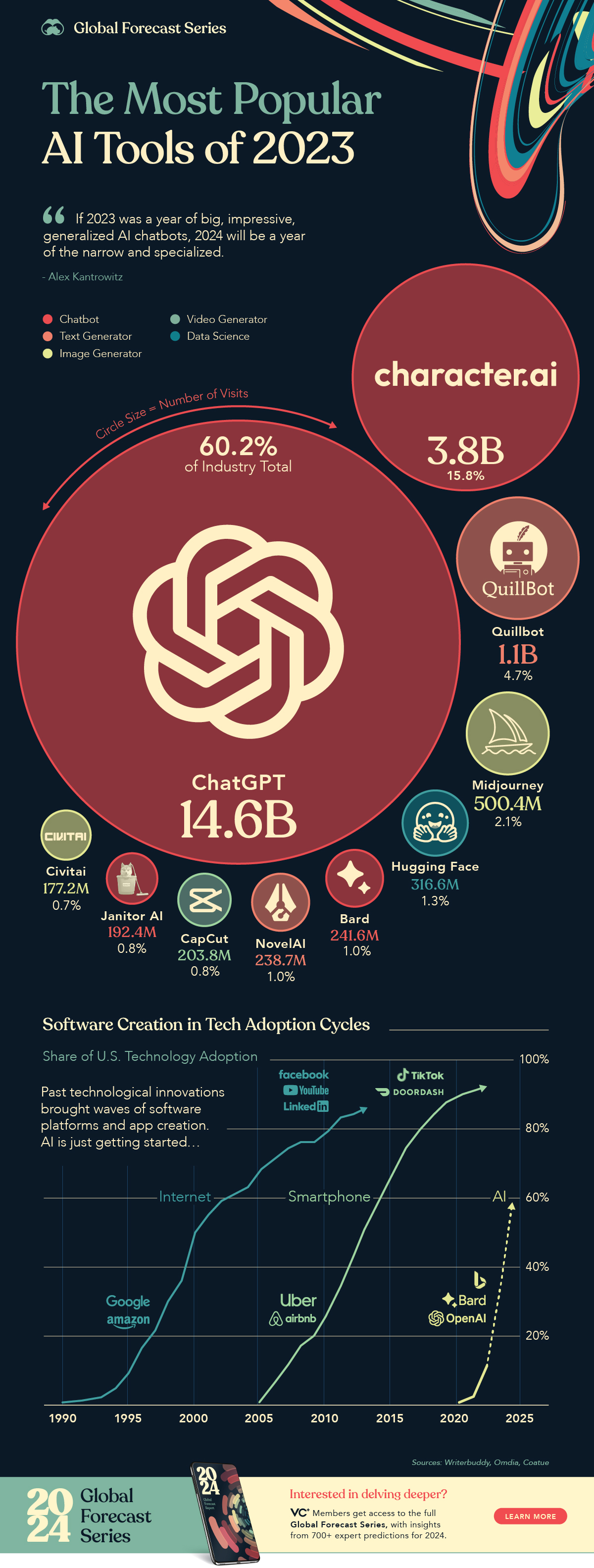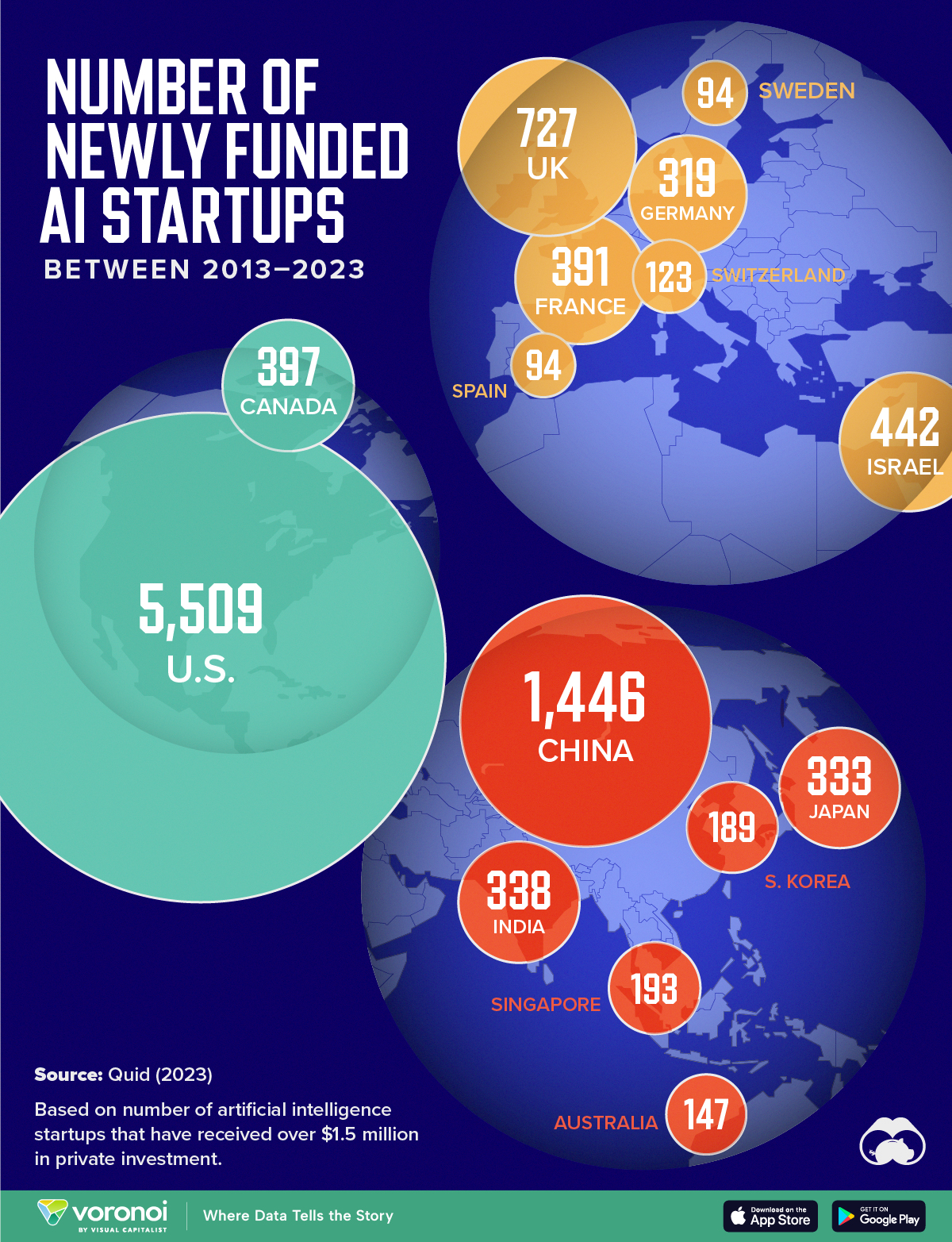

Mapped: The Number of AI Startups By Country
This was originally posted on our Voronoi app. Download the app for free on iOS or Android and discover incredible data-driven charts from a variety of trusted sources.
Amidst the recent expansion of artificial intelligence (AI), we’ve visualized data from Quid (accessed via Stanford’s 2024 AI Index Report) to highlight the top 15 countries which have seen the most AI startup activity over the past decade.
The figures in this graphic represent the number of newly funded AI startups within that country, in the time period of 2013 to 2023. Only companies that received over $1.5 million in private investment were considered.
Data and Highlights
The following table lists all of the numbers featured in the above graphic.
| Rank | Geographic area | Number of newly funded
AI startups (2013-2023) |
|---|---|---|
| 1 | United States | 5,509 |
| 2 | China | 1,446 |
| 3 | United Kingdom | 727 |
| 4 | Israel | 442 |
| 5 | Canada | 397 |
| 6 | France | 391 |
| 7 | India | 338 |
| 8 | Japan | 333 |
| 9 | Germany | 319 |
| 10 | Singapore | 193 |
| 11 | South Korea | 189 |
| 12 | Australia | 147 |
| 13 | Switzerland | 123 |
| 14 | Sweden | 94 |
| 15 | Spain | 94 |
From this data, we can see that the U.S., China, and UK have established themselves as major hotbeds for AI innovation.
In terms of funding, the U.S. is massively ahead, with private AI investment totaling $335 billion between 2013 to 2023. AI startups in China raised $104 billion over the same timeframe, while those in the UK raised $22 billion.
Further analysis reveals that the U.S. is widening this gap even more. In 2023, for example, private investment in the U.S. grew by 22% from 2022 levels. Meanwhile, investment fell in China (-44%) and the UK (-14.1%) over the same time span.
Where is All This Money Flowing To?
Quid also breaks down total private AI investment by focus area, providing insight into which sectors are receiving the most funding.
| Focus Area | Global Investment in 2023 (USD billions) |
|---|---|
| AI infrastructure, research, and governance |
$18.3 |
| Natural language processing |
$8.1 |
| Data management | $5.5 |
| Healthcare | $4.2 |
| Autonomous vehicles | $2.7 |
| Fintech | $2.1 |
| Quantum computing | $2.0 |
| Semiconductor | $1.7 |
| Energy, oil, and gas | $1.5 |
| Creative content | $1.3 |
| Education | $1.2 |
| Marketing | $1.1 |
| Drones | $1.0 |
| Cybersecurity | $0.9 |
| Manufacturing | $0.9 |
Attracting the most money is AI infrastructure, research, and governance, which refers to startups that are building AI applications (like OpenAI’s ChatGPT).
The second biggest focus area is natural language processing (NLP), which is a type of AI that enables computers to understand and interpret human language. This technology has numerous use cases for businesses, particularly in financial services, where NLP can power customer support chatbots and automated wealth advisors.
With $8 billion invested into NLP-focused startups during 2023, investors appear keenly aware of this technology’s transformative potential.
Meeting experts weigh the positive aspects of generative AI
The introduction of Artificial Intelligence (AI) into the meetings industry has become a certified gamechanger. But how exactly can AI help meeting planners tackle their everyday jobs? Smart Meetings chatted with Amy Kramer, innovation leader for Maritz; Nick Borelli, an instructor at PCMA Event Leadership Institute and marketing director with Zenus Inc.; and Alex Berube, co-founder of New York City-based Reposite to discuss this trending technology topic.
Using AI Professionally
After Berube’s wedding in December of last year, she had the idea to use AI to turn her wedding photograph into a business headshot for her LinkedIn page. The result was a professional-looking picture that captured her in the best light with only one problem. It added an extra finger to her hand. “I did have to do some editing, they can do some pretty cool stuff,” she quipped.
In regards to meeting planning, Berube suggested using Google’s free AI app, Geminito find the best flights down to the day of the week and time of day. “AI is basically telling you that this is when you’re most likely to get the cheapest flights possible,” she shared.
Read More: Why It is Time to Get Serious About AI for Events
Borelli pointed to post-event surveys as an arena where the power of AI can create better results than humans trying to analyze large quantities of data. “You can take years of post-event surveys, which is something that I think no one ever had done prior to that, and sort them with generative AI to see patterns and trends.”
Kramer agreed, “We sit on so much data and when you can connect different parts and pieces of data that surround an event. My favorite application is when it can find unlikely connections with the data and serve up recommendations, or thoughts that I wouldn’t have necessarily found on my own, because I have not been looking for it.”
Apps for Data Analysis
Ready to move beyond ChatGPT and looking for specialized tools? The experts suggested:
- Microsoft Co-Pilot
- SPARK from PCMA/Gevme
- Google Gemini
- Polymer Search
- Reposite (RFPs and proposals)
- Otter.AI (Notetaker)
- Open AI DALL-E (Image creator)
AI for Meeting Planners
In a Smart Meetings White Paper on AI, published in January, 63% of respondents said they believe AI use in events is a valuable tool, while 31% said AI is a game-changer.
“AI gives you time and resources,” says Borelli, “It is game changing.”
Getting started with AI
For those timid about jumping into AI, Kramer suggested looking at the tool as a way to overcome the mental blocks of being a creator. “AI helps to extend that value of the event planner from just the day-to-day logistics, all of the things that engulf their day-to-day schedule. Let AI take that so we can be more creative in our roles.”
Planners who aren’t looking to commit to a monthly subscription of ChatGPT or other AI apps, have the option to try the free versions, but performance and security often increase in the paid versions.
Whether using free or paid versions, all three experts stressed the importance of making it a starting point. Ask AI to take more time and/or check its work. And always review.
Read More: Top Event Technology Trends for 2024
Kramer called it “keeping a human in the loop” at all times. Check for accuracy and improve on the computer-generated result rather than copying and pasting.
“I think it’s not always about what the AI tool can do, because people are better than machines, regardless. It’s how you can leverage that to your advantage and use it to produce great work,” Kramer continues, “Don’t be afraid of it. Get out there and explore. Use it yourself.”
“There’s a lot of things we have to do to run a global two-sided marketplace and time is money,” says Berube. “If I can do something more efficiently using these tools, I absolutely owe it to the success of our business to do that.”
Creating Accessibility and Empathy with AI
Once planners have onboarded their AI assistants for the basic tasks, how will they use all of their extra time to improve attendee experiences?
Borelli suggests shifting their focus to areas such as accessibility. “AI can be used for providing windows into the perspectives of people we don’t normally design for,” he says. When you design an element, AI can help uncover the challenges it creates for divergent populations. “Overcoming those challenges requires human empathy and creativity we’re going to be using more.”
Meeting planner who use AI tools to listen to attendee’s needs will allow planners to create designs that are more accommodating and create a better sense of belonging, Borelli says.



I’m excited to share that the Deel team will be participating in the upcoming WERC Regional Summit in Singapore.